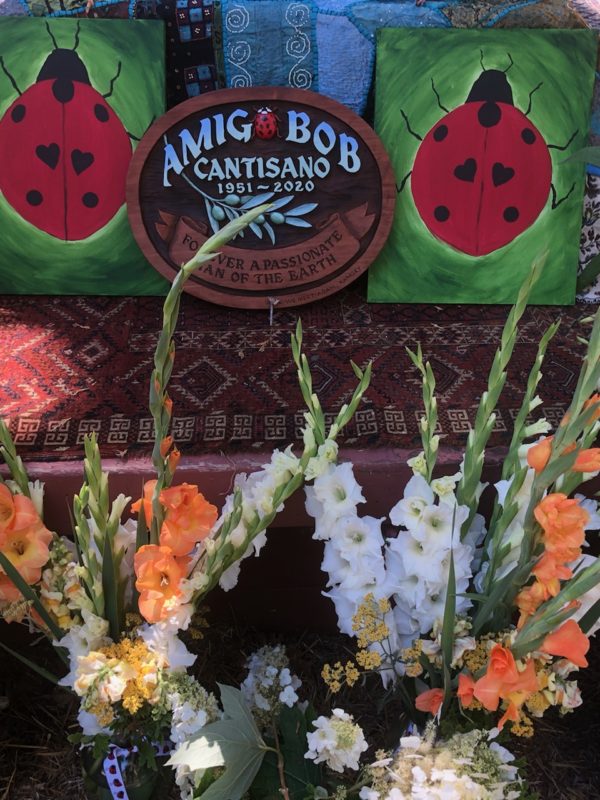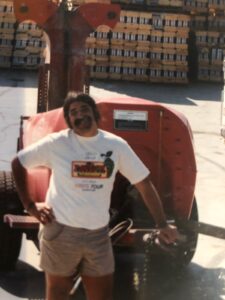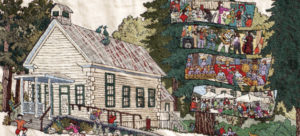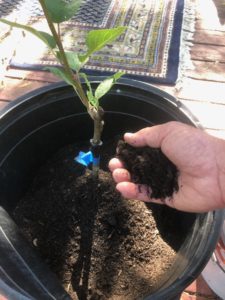We Are Stardust

A little country schoolhouse in the woods adjacent to the site of one of America’s most egregious environmental crimes made a perfect setting for the memorial service. A gentle breeze stroked the pines and eased the 102-degree summer heat as the mourners began to arrive. Many folks tumbled out of vans or stepped down from pick-up trucks, brightly dressed for the occasion in their best tie-dyed formal wear as had been suggested by the grieving family. I didn’t see any black in the crowd, but there were also people in colorful prints and stripes, and a few folks chose to wear next to nothing at all. Excited children ran loose on the grass in the sun and there were glass pitchers of iced, herbal teas and lemonade waiting in the shade. You could hear the music of acoustic guitars and harps coming from a duo down by the makeshift altar where the grownups were gathering. There was a life to be celebrated and honored here, but first let’s talk about the crime.
Malakoff Diggins on the San Juan Ridge North of Nevada City in the Sierra Nevada Gold Country is a vast blight on the landscape that has been re-imagined as a State Park. When California’s Gold Rush matured in the mid1850s the business of gold mining became very industrialized. Gone were the days of the ’49ers bent over in a river panning for gold nuggets. Capitalists raised money for mining companies to dam creeks and rivers high in the mountains. Then they’d cut down the pine forests to build wooden sluices that would guide the wild water down from great heights to the lower elevations in the foothills. The sluices would be channeled into huge hoses and, thanks to the tremendous pressure from the dramatic descent, the water exploded out of the nozzles with violent, cutting force. Whole hillsides would be washed away in a muddy torrent and the raging slurry would be strained for gold through a series of sluices. Malakoff Diggins is the scar left from one of the largest hydraulic mines. There are eroded canyons where there once were hills. The soil was washed away down to bedrock so a visitor can see deep into the planet’s bones. The park’s stunted forest is struggling to heal the violated earth.
To California’s 19th Century mining industry, it didn’t matter that her forests were destroyed. It wasn’t relevant to the shareholders of the mining corporations that the mud flows from their hydraulic mining polluted rivers and destroyed fisheries and whole ecosystems. It wasn’t a problem for the mining industry that the waste from hydraulic mining destroyed farm fields and flooded cities and ruined bays and wetlands downstream. The only thing that mattered to the mining companies was extracting gold from the ground as fast and as cheaply as possible. The miners had zero social consciousness and their “industry” was a rape. The only thing the mining companies could have done to behave in a less socially conscious manner would have been to use slave labor.
Eventually, the number of citizen victims in California so vastly outnumbered the handful of capitalists who controlled the hydraulic mining business that it became politically expedient for the California Legislature to pass America’s first environmental legislation and ban hydraulic mining. It helped that the Sacramento River, which passes close by to California’s Legislature, was so full of mud from the mines that it overflowed frequently and flooded the politicians. The law was important not only because it put a halt to an egregious crime against our environment but also because it set precedent by showing how the wellbeing of the body politic was dependent on the wise management of the land and water resources that sustain the community. Maybe that moment when our legislature first acted with an awareness of the environment was an inflection point; at any rate, starting in the late 19th Century there was a growing social awareness of our role in destroying or conserving our shared environment. At first it seemed like only the poets and artists and mystics and bohemian freaks could see our natural world as anything more than a piggy bank to be busted open for coins.
Amigo Bob was born in 1951. Post War America was the boom time for chemical  agriculture. The threat we face from chemical residues in our food and water is never as obvious as a wave of mud spilling over a riverbank but it’s just as real. In the late 50’s consumers were ignorant and didn’t understand about the ways chemical laced runoff from farms was altering and degrading our rivers, lakes, and aquifers. We didn’t have a widespread public understanding of our farmlands as an irreplaceable resource to be conserved. The “modern” in everything was being fetishized and what had been traditionally valued was seen as outdated, so antique varieties of grains, fruits and vegetables were being forgotten from cultivation. The Universities only taught the gospel of “Better Living Thru Chemistry.” But there was also a nascent counterculture springing up that sought to reconnect our society with the natural world that sustains us. Joni Mitchell captured the moment in her song, Woodstock; “We are stardust,” she sang. “We are golden. And we’ve got to get back to the garden.” Amigo Bob had a hippy memorial service because he was a straight up, tie-dyed in the wool, unapologetic and incurable hippy.
agriculture. The threat we face from chemical residues in our food and water is never as obvious as a wave of mud spilling over a riverbank but it’s just as real. In the late 50’s consumers were ignorant and didn’t understand about the ways chemical laced runoff from farms was altering and degrading our rivers, lakes, and aquifers. We didn’t have a widespread public understanding of our farmlands as an irreplaceable resource to be conserved. The “modern” in everything was being fetishized and what had been traditionally valued was seen as outdated, so antique varieties of grains, fruits and vegetables were being forgotten from cultivation. The Universities only taught the gospel of “Better Living Thru Chemistry.” But there was also a nascent counterculture springing up that sought to reconnect our society with the natural world that sustains us. Joni Mitchell captured the moment in her song, Woodstock; “We are stardust,” she sang. “We are golden. And we’ve got to get back to the garden.” Amigo Bob had a hippy memorial service because he was a straight up, tie-dyed in the wool, unapologetic and incurable hippy.
 The North Columbia Schoolhouse is a community center for the people who live up and down the San Juan Ridge. The Malakoff Diggins State Park is just around the corner. Amigo Bob may have started off in San Francisco, but he ended up living and farming nearby. What a difference one hundred years makes. Where the gold miners had seen the soil on San Juan Ridge as an obstruction inconveniently hiding treasure, the hippies like Amigo Bob saw the soil as the real treasure. Where the mining companies had no shame in flushing their unfiltered wastes into the whole public’s ecosystem, the hippies envisioned a movement back to the land characterized by a rainbowed network of environmentally sustainable communities where nature was recognized as a partner, not as an adversary. Amigo Bob came out of that loose, nature-centric hippie community and he lived his life as an activist for those life-affirming, scientific, and transcendent values. Amigo Bob put the “active” in “activist.”
The North Columbia Schoolhouse is a community center for the people who live up and down the San Juan Ridge. The Malakoff Diggins State Park is just around the corner. Amigo Bob may have started off in San Francisco, but he ended up living and farming nearby. What a difference one hundred years makes. Where the gold miners had seen the soil on San Juan Ridge as an obstruction inconveniently hiding treasure, the hippies like Amigo Bob saw the soil as the real treasure. Where the mining companies had no shame in flushing their unfiltered wastes into the whole public’s ecosystem, the hippies envisioned a movement back to the land characterized by a rainbowed network of environmentally sustainable communities where nature was recognized as a partner, not as an adversary. Amigo Bob came out of that loose, nature-centric hippie community and he lived his life as an activist for those life-affirming, scientific, and transcendent values. Amigo Bob put the “active” in “activist.”
In the early ’70s Amigo Bob worked with other consumers to create food buying clubs that could source organic, chemical-free foods for the members. When he found that there was very little organic food to be had he started farming. When he ran into the inevitable challenges as an organic grower he began researching organic farm supplies and ended up starting Peaceful Valley Farm Supply in Grass Valley, a first generation organic farm supply business that is still serving the industry today. When the growth of the organic food business created concerns about standards, Amigo worked with others to link farmers together to craft reasonable, enforceable and transparent standards for the industry. He persisted in trying to get the Universities to work on the challenges facing organic agriculture. When the schools were slow to take up the challenge of learning how to solve agricultural problems organically, Amigo Bob worked with others to create the Eco Farm Conference, which brought farmers, scientists, and activists together. Amigo farmed olives and his olive oil business brought him into the world of fine dining and he helped create an awareness among chefs about the role small farms could play in supplying Restaurant kitchens with fresh ingredients. He worked to save rare and endangered fruit varieties from being lost and he founded the Gillet Institute to institutionalize these goals. https://felixgillet.org/ . Amigo started a farming consulting business to help teach other aspiring and established farmers what he’s learned. For a fitting coda to his life Amigo chose to be composted and turned back into the earth instead of having his body embalmed and boxed up.
together to craft reasonable, enforceable and transparent standards for the industry. He persisted in trying to get the Universities to work on the challenges facing organic agriculture. When the schools were slow to take up the challenge of learning how to solve agricultural problems organically, Amigo Bob worked with others to create the Eco Farm Conference, which brought farmers, scientists, and activists together. Amigo farmed olives and his olive oil business brought him into the world of fine dining and he helped create an awareness among chefs about the role small farms could play in supplying Restaurant kitchens with fresh ingredients. He worked to save rare and endangered fruit varieties from being lost and he founded the Gillet Institute to institutionalize these goals. https://felixgillet.org/ . Amigo started a farming consulting business to help teach other aspiring and established farmers what he’s learned. For a fitting coda to his life Amigo chose to be composted and turned back into the earth instead of having his body embalmed and boxed up.
As an activist Amigo Bob really covered all the bases and his memorial service was a chance for the community that he sprang from and inspired to gather together and say thanks for a life well lived. Amigo will be missed but the crowd that gathered to remember him spanned all ages and the work goes on. Amigo would be happy to see that the environmental values that he promoted are gathering momentum as day-by-day more people learn to see our shared world from a more holistic perspective.
“All of your actions, no matter how small, can have a huge impact on the environment and all the humans and creatures that inhabit it.”
Amigo Bob 1951- 2020
—© 2021 Essay by Andy Griffin and photos by Starling Linden and Andy Griffin
~Special Note~
As the weather is getting warmer, the sun is rising earlier and the harvesting begins with the sunrise, we will be closing our East Bay/Peninsula shop by 6 PM on the Wednesday evenings before the Friday delivery. We close our San Francisco & Mystery Thursday shops on Wednesday mornings by 8 AM and our Santa Cruz/Los Gatos shop by 8 AM, on Monday mornings. Please get your orders in early so you don’t miss out on the harvest! Thank you all again for being such a part of our bountiful farm!
If you haven’t ordered a Mystery Box recently, now is a great time to get in on spring deliciousness! LadybugBuyingClub


